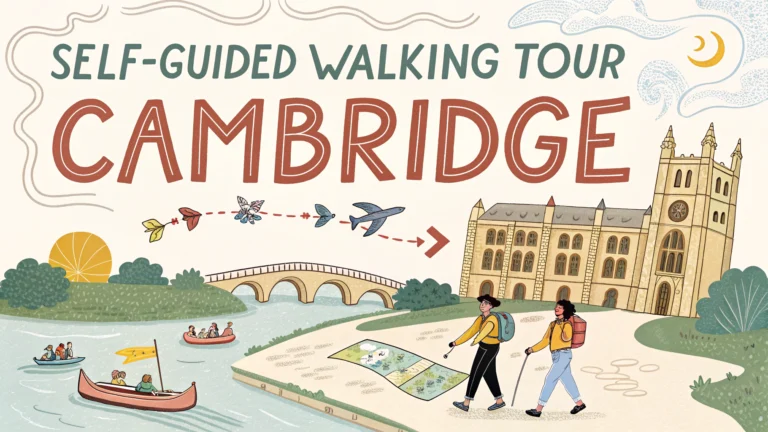Taking a self-guided walking tour through Cambridge offers a perfect way to explore this historic university city at your own pace.
Essential Walking Route
Start your journey at the Cambridge Visitor Information Centre (Address: Peas Hill, Cambridge CB2 3AD).
- King’s Parade – Walk north to see King’s College Chapel, arguably Cambridge’s most iconic landmark
- Trinity College – Continue to Trinity Street to view the largest Cambridge college
- St John’s College – Admire the Bridge of Sighs spanning the River Cam
- Round Church – One of only four round churches remaining in England
- Market Square – Browse local vendors and grab refreshments
Key Photo Stops
- Mathematical Bridge at Queens’ College
- The Backs – riverside college gardens
- Senate House passage
- Great St Mary’s Church tower (£6 entry fee for panoramic views)
Practical Tips
The complete walking route covers approximately 2 miles and takes 2-3 hours at a leisurely pace.
Most colleges charge entrance fees (typically £5-10) and may restrict access during exam periods.
Download the free Cambridge City Council walking tour map from their website before starting.
Best Times to Visit
| Season | Benefits |
|---|---|
| Spring/Summer | Pleasant weather, college gardens in bloom |
| Early Morning | Fewer tourists, better photography |
| Term Breaks | Easier college access |
Alternative Routes
For a shorter walk, focus on the central colleges along King’s Parade and Trinity Street.
Nature enthusiasts should extend their walk through the University Botanic Garden (£7 admission).
Accessibility Notes
Most streets are cobbled, but main pathways are wheelchair accessible.
Public restrooms are available at the Grand Arcade Shopping Centre and Market Square.
Several cafes along the route offer rest stops, including Fitzbillies (51-52 Trumpington St) and Auntie’s Tea Shop (1 St Mary’s Passage).
Emergency Information
Cambridge Police Station: Parkside, Cambridge CB1 1JG, Tel: 101
Addenbrooke’s Hospital (Emergency): Hills Road, Cambridge CB2 0QQ, Tel: 01223 245151
Additional Attractions
Several noteworthy sites lie just off the main walking route:
- Fitzwilliam Museum – Free entry to world-class art collections
- Cambridge Market Quarter – Independent shops and eateries
- Parker’s Piece – Historic green space where football rules were standardized
Evening Extensions
Riverside Walk
Follow the River Cam northward past the college boathouses to witness student rowing teams practicing. Continue to Midsummer Common for riverside dining options.
Ghost Tours
Join evening walking tours departing from the Visitor Centre at 6:30 PM (£12 per person) to discover Cambridge’s haunted history.
Seasonal Events
- May Week celebrations (June)
- Cambridge Folk Festival (July/August)
- Literary Festival (April)
- Christmas Market (December)
Conclusion
A self-guided walking tour provides an intimate introduction to Cambridge’s academic heritage and architectural splendor. The flexible nature allows visitors to explore hidden courtyards, adjust their pace, and immerse themselves in the city’s scholarly atmosphere.
Remember to respect current students and staff by following posted notices and maintaining appropriate noise levels, particularly near academic buildings.
FAQs
- What is the best time of year for a self-guided walking tour in Cambridge?
Late spring (May-June) and early autumn (September-October) offer the best weather and fewer tourists. The colleges are also fully accessible during these periods, outside of examination times. - How long does a typical self-guided walking tour of Cambridge take?
A comprehensive tour covering the main university colleges and historic sites typically takes 2-3 hours, though this can be extended to a full day if you plan to enter multiple colleges and museums. - Which are the must-see colleges on a Cambridge walking tour?
King’s College (with its famous chapel), Trinity College, St. John’s College, and Queens’ College are considered essential stops, known for their historic architecture and stunning courtyards. - Is there an entrance fee for Cambridge colleges?
Yes, most colleges charge an entrance fee (typically £5-10 per college). King’s College has the highest entrance fee, but some colleges offer free admission during certain hours or seasons. - What’s the best starting point for a self-guided walking tour?
The Grand Arcade area or King’s Parade are ideal starting points, both centrally located and easily accessible from the train station via bus or a 20-minute walk. - Can you visit Cambridge colleges year-round?
No, colleges have varying opening hours and may close during term examinations, special events, or holidays. It’s essential to check individual college websites for current access times. - Is the River Cam part of the typical walking route?
Yes, the River Cam is a crucial part of most walking tours, particularly along The Backs, where you can see famous bridges like the Mathematical Bridge and the Bridge of Sighs. - Are there public restrooms available along the walking route?
Yes, public toilets are available at the Grand Arcade, Market Square, and Lion Yard shopping center. Some colleges and cafes also have facilities for customers. - Is it possible to combine punting with a walking tour?
Yes, many visitors combine walking tours with punting, typically starting or ending their walk at the punting stations near Magdalene Bridge or Mill Lane. - Are guided maps available for self-guided tours?
Yes, free maps are available from the Tourist Information Centre on Peas Hill, and many hotels and shops offer Cambridge walking tour maps. Digital maps can also be downloaded from the Visit Cambridge website.








